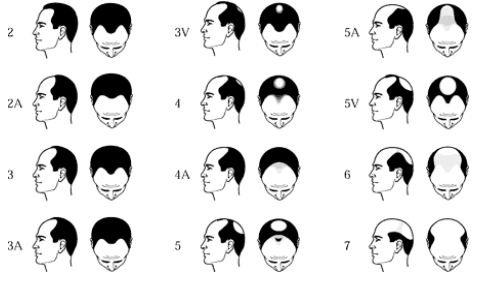Noticing a receding hairline can be devastating, but knowledge is power.
Receding hairlines can affect men and women of all ages for different reasons. The most common cause for men is male pattern baldness, caused by genes that make the hair susceptible to dihydrotestosterone (DHT). DHT makes hair follicles shrink, leading to hair loss. Women can also experience receding hairlines but more often, female hair loss is diffuse. It can be related to DHT, but it’s typically a result of lowered estrogen levels with menopause.
Hair Loss Caused by Medications
Some drugs can also induce hair loss. For example, hormone replacement therapy is becoming common place for men and women who are seeking to maintain youthfulness, energy levels and muscle mass. Sometimes HRT includes progesterone and testosterone, which will increase your DHT levels. This can cause a sudden progression of hair loss.
When considering treatment, it’s important to understand the different stages of hair loss.
Stages of Male Pattern Baldness
Male pattern baldness is grouped in stages according to the Norwood Scale, a set of images that divides receding hairlines into seven levels and 2 types:
 Stage I Male Pattern Baldness shows minimal hair loss. Hair still appears full, and hair loss is generally unnoticeable. This type would be considered “normal” for a young man in his teens and 20s. If you are still stage I in your 30s, consider yourself lucky.
Stage I Male Pattern Baldness shows minimal hair loss. Hair still appears full, and hair loss is generally unnoticeable. This type would be considered “normal” for a young man in his teens and 20s. If you are still stage I in your 30s, consider yourself lucky.
Stage II indicates hair loss is beginning around the temples but it is too insignificant to be visible. Sometimes this can seem to occur rather suddenly when a man is in his early 20s and the last surge of puberty hits. It can be the cause for alarm for a young man, but it does not necessarily mean you are destined to be bald.
Stage III Male Pattern Baldness is the stage at which hair loss becomes visible with deeper temporal recessions. For a man in his 40s, this could be considered “normal,” as the majority of men experience some degree of hair loss as they age. It is also the first stage at which treatment becomes viable.
Stage IV shows continuing hair loss around the hairline and more visible thinning at the vertex. If you are trying to slow down the progression, you will definitely want to initiate treatment here, and transplant may be an option.
Stage V Male Pattern Baldness depicts larger areas of hair loss at the front and top of the head, but at this stage, there is still some hair left in the midscalp to separate the areas of hair loss between the front and back, or hairline and crown.
Stage VI shows very significant hair loss. Most of the hair on top of the head has been lost at this point. There may be some thin hair between the receding hairline and vertex, but in general, it is one continuous area of hair loss. Some people refer to this pattern as the “horseshoe,” because the hair that remains is in the shape of a “U” around the sides and back of the scalp. It would take multiple sessions of transplant to restore this pattern and that is dependent on the donor availability, which at this point, is usually not abundant.
Stage VII Male Pattern Baldness the most extreme stage on the Norwood Scale, means there is little to no hair at the front and top of the head. The remaining hair sits low above the ears and at the back of the head.
Male Pattern Baldness: Vertex & Anterior Types
Intermingled with the 7 stages of the Norwood Scale is the Vertex Type and the Anterior Type. The Vertex Type is described above in stages II-VII and is the more typical hair loss pattern for men. The Anterior Type follows Stages III-V and instead of separate areas of hair loss (hairline and crown), you have a progressive backward march of the hairline. The further back your hairline sits, the higher the corresponding stage.
Women may find themselves pictured on the Norwood Scale, but more often their pattern will be defined by the Sinclair or Ludwig scales for hair loss.
Male Pattern Baldness Treatment Options
Depending on the stage of hair loss, individuals experiencing receding hairlines may seek treatment to restore their hair. Everyone loses hair differently, and treatments may vary.
Early treatment is critical to success, and the highest response rates have been shown to occur with combination therapy. Combining a topical medication such as minoxidil (Rogaine) with an oral medication such as finasteride (Propecia), produces a synergistic response. Minoxidil (Rogaine), which reinvigorates shrunken hair follicles, while finasteride (Propecia), interferes with testosterone activation to DHT, blocking the signal for hair loss. Combination therapy is recommended for a minimum of six months to one year in order to see results.
Hair transplants are a viable option for many patients. There are different types of procedures, but essentially all hair transplants take hair from areas of the scalp that have stronger hair (namely the back or sides), and place them in areas of baldness. There are currently two methods of hair transplants: follicular unit transplantation (FUT) and follicular unit excision (FUE). Both methods are outpatient procedures which we perform at the Limmer Hair Transplant Center in Texas.
Contact us to learn more about your hair loss options, or to make an appointment today. We’re hair restoration experts who can help you decide which treatment is best for you.







